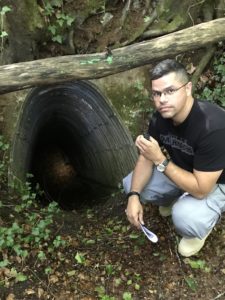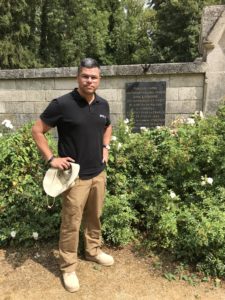Even today French locals, other Europeans and Americans find themselves drawn to the Meuse-Argonne region of France. Once drawn there, many return time and again; often working on a multi-year research or preservation project. In this irregular series, the Webmaster hopes to introduce readers to some of these individuals and their labors of love.
1) What are your name, nationality and occupation?
My name is Mike Cunha. I am an American, and I work as a social studies / history teacher. In my personal time I research, write and produce the “Battles of the First World War Podcast.”
2) Which languages do you speak, and how fluently do you speak them?
I am fluent in European Portuguese, very rough in German, and marginally above abysmal in French. (Although I must say: My comprehension of French improved several times over with my 10-day trip to the Argonne and the Somme in August. My spoken responses remain solidly unsatisfactory, though.)
3) When was your first visit to the Meuse-Argonne?
My first in-depth visit to the Meuse-Argonne was in February 2016; my stepson Lee and I were in Verdun for the 100th anniversary of the opening of the 1916 battle. By then I had completed my fourteen podcast episodes on the Battle of Verdun, and we walked much of the battlefield.
4) When did you really find yourself drawn to the Meuse-Argonne?
During the 2016 visit, I absolutely fell in love with the region. The small villages and hamlets, the wide, rolling fields, the unending skies above, the thick forests, and the history of the Meuse-Argonne instantly made it a place to which I will always want to return.
5) What is your primary interest in the region?
My primary interest in the area is its First World War history. Whenever I drive through the area, I can almost see American Doughboys running across the forest roads, or through the fields. At Verdun the ground itself tells you the story of the titanic clash between the French and German armies there.
6) Approximately how many times and/or how often do you visit the Meuse-Argonne?
The first words that come to mind on the question of how often are “not enough!” I have just completed my second trip there, where my stepson Lee, my Army buddy Chuck, and I spent five very packed days touring the American points of the Meuse-Argonne. I am already scheming and plotting towards my next trip.
7) What do you do when you visit?
My visits to the Meuse-Argonne have been focused on the WW1-era history of the region. In 2016 we spent the majority of our time walking the Verdun battlefield, with a rainy day’s sojourn to American points of interest. This past trip was focused almost exclusively on places of the American Meuse-Argonne Offensive of 1918.
8) What research or preservation projects are you working on currently?
In my (currently limited) spare time, I research, write and produce the “Battles of the First World War Podcast.” My goal is to go in-depth to the events and people of WW1 battles. My next project is the American-led Meuse-Argonne Offensive of 1918. With my current rate of production, this project will likely take upwards of a year to complete.
9) What research or preservation projects have you completed in the past?
The “Battles of the First World War Podcast” thus far contains the stories of the battles of Verdun, the Somme, Seicheprey, and Belleau Wood. With each battle I try to get into the details and tell as much of the whole story as I can–as can be evidenced by the 30 episodes it took for me to complete the Somme. There’s just so much to talk about.
10) What is your favorite spot in the Meuse-Argonne, and why?
For battlefields the American Memorial at Montfaucon is stunning, and it offers breathtaking views of the Meuse-Argonne battlefields. For reflection and meditation, a visit to the Meuse-Argonne American Cemetery is a moving experience. I’d add that visiting some of the many French and German cemeteries in the area also bring home a real sense of how expensive the war was in terms of human lives.
11) History aside, what is your favorite thing to do in the Meuse-Argonne?
Another really enjoyable part of our trips to France has been shopping in the grocery stores, where everything tastes absolutely delicious. We’ve gone the AirBnB route for our stays in France, and so we cook many of our own meals when we stay. I also have enjoyed stopping at Jean-Paul DeVries’ Romagne ’14-’18 restaurant / museum for a meal. He is such a wonderful host.
12) Schedule permitting, would you consider being a tour guide for individuals or groups traveling to the sector?
In a couple of years my schedule will be much more open and I could potentially do something like that. The opportunity to dive in-depth into WW1 history, then visit all of these places and talk about them? Yes, absolutely.
13) How can readers contact you for assistance or for more details?
If anyone has any questions, or wants more details on a subject, there are several ways they can contact me. On FaceBook, there is a “Battles of the First World War Podcast” page. I’m on Twitter with @WW1podcast, and perhaps the easiest way is through my email address [email protected].
14) Any other comments?
If you can, visit the Meuse-Argonne area for a few days. It is such a beautiful part of the world, and it is rich in history. As Webmaster Randy says, get out into the villages and hills and fields. This is where history happened, and you can walk in the footsteps of so many thousands and millions of Poilus, Frontkaempfer, and Doughboys while meeting so many friendly and inviting local folks.



